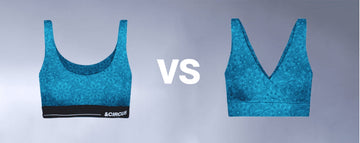Quick Listen:
Sweat-soaked summers and clingy fabrics are enough to make anyone rethink their underwear drawer. Yet, in an era where comfort is king, a quiet revolution is unfolding in the world of intimate apparel. From eco-conscious micromodal blends to high-tech textiles that wick moisture like a dream, fabric innovations are transforming underwear into a breathable, skin-friendly sanctuary for men, women, and expecting mothers. The push for sustainability and performance has never been so seamlessly stitched together, and it's changing how we think about our most personal layers.
Uncomfortable underwear shouldn't steal your confidence. At Andcircus, we craft ultra-soft, sustainable Lenzing Modal Micro® innerwear for every body, XS to 5XL. From briefs to bras, our custom packs fit you perfectly. Shop risk-free with our 100% satisfaction guarantee and embrace comfort that includes everyone. #LoveEveryBody. Shop Now!
Next-Gen Fabrics Boost Breathability in Sustainable Innerwear
Innovations in micromodal blends and textile engineering are redefining comfort, airflow, and skin health in eco-conscious underwear for all body types and life stages. This isn't just about feeling good it's about fabrics that work smarter, from regulating body temperature to reducing environmental impact. The global underwear market, valued at approximately USD 90 billion in 2023, is projected to reach USD 140 billion by 2032, growing at a 5% CAGR, driven by consumers prioritizing hygiene, comfort, and style. The men's segment alone, worth USD 20,545.7 million in 2024, is expected to surge to USD 104,431.7 million by 2033, with a CAGR of 19.8%, fueled by demand for sustainable, comfort-focused designs.
Why the obsession with breathability? It's more than just staying cool. Breathable fabrics promote hygiene by reducing moisture buildup, a key factor in preventing skin irritation, especially for sensitive groups like pregnant women. As urban lifestyles and active routines dominate, consumers are seeking underwear that feels like a second skin, whether they're navigating a humid city commute or a prenatal yoga class.
The Science of Staying Cool
At the heart of this transformation are cutting-edge fabric technologies. Micromodal, derived from beechwood pulp, is a standout for its softness and natural airflow. Unlike traditional cotton, micromodal blends, often paired with TENCEL™, offer superior moisture-wicking properties, pulling sweat away from the skin to keep you dry. According to research on advanced thermoregulatory textiles, these fabrics shape body microclimates by regulating heat transfer, creating a cooling effect without energy waste. The result? Underwear that feels like a breeze, even in sweltering conditions.
Then there's the rise of 3D-knit and open-weave textures. Circular knitting techniques create micro-ventilated patterns, allowing air to circulate freely while maintaining structural integrity. Some brands are even weaving in phase change materials (PCMs), which absorb and release heat to stabilize body temperature. These aren't your average briefs or boxers these are garments engineered for performance, whether you're sprinting through a workout or lounging at home. And with 40% growth in demand for moisture-wicking, antibacterial, and stretchable fabrics, as noted in market reports, it's clear consumers are all in for these advancements.
From Runways to Real Life
The influence of athleisure can't be ignored. What started as a trend for yoga pants in the mid-2000s has spilled over into underwear, with boxer briefs, hipsters, and maternity bras borrowing from athletic wear's playbook. Boxer briefs now dominate men's underwear sales at 45%, while trunks and briefs are seeing 30% growth, driven by fashion-forward designs that prioritize comfort. Brands are blending micromodal with stretchy, breathable weaves to create pieces that move with you, whether you're hitting the gym or chasing a toddler.
Take maternity wear, for instance. Expecting mothers, prone to overheating and skin sensitivity, benefit from lightweight, breathable fabrics that reduce irritation. One brand's micromodal maternity bra, designed with open-weave panels, has earned raves for keeping users cool during humid summers. In men's underwear, premium labels are leaning into sustainable materials like bamboo and organic cotton, which offer natural breathability while aligning with eco-conscious values. These designs shine in diverse climates, from sticky tropical cities to dry, chilly regions, proving that breathability isn't a one-size-fits-all promise.
The Eco-Conundrum
But it's not all smooth sailing. Balancing sustainability with high-tech enhancements is a tightrope walk. Micromodal and TENCEL™ are eco-friendly, biodegradable options, but integrating nanotechnology or PCMs often requires synthetic additives, which can clash with strict eco-certifications. Supply chain hurdles also loom large specialty yarns like micromodal are pricier, and ethical manufacturing adds to the cost. As raw material prices rise, brands face the challenge of keeping products affordable without compromising quality.
Then there's the confusion over terms like “breathable” versus “moisture-wicking.” Shoppers, bombarded with marketing buzzwords, sometimes struggle to distinguish between fabrics that truly ventilate and those that merely manage sweat. This gap in consumer education can dilute trust, especially when brands overpromise. Still, the industry is learning. Transparent labeling and third-party certifications are helping shoppers make informed choices, ensuring that “eco-friendly” isn't just a feel-good tag.
Seizing the Moment
For brands, the opportunities are ripe. Breathable, sustainable underwear taps into the booming wellness and athleisure markets, where consumers crave products that align with their health-conscious lifestyles. Maternity lines, in particular, are a goldmine breathable fabrics address real pain points like overheating, making them a go-to for expecting mothers. The men's market, too, is shifting, with 28% of global sales driven by U.S. consumers who prioritize premium, comfort-driven designs, per industry insights.
Smart brands are doubling down on innovation to stand out. Some are experimenting with subscription models, offering daily-wear basics with a comfort guarantee. Others are blending underwear with athleisure aesthetics, creating hybrid pieces that transition from gym to office. By positioning breathable innerwear as a lifestyle essential, companies can capture loyal customers who value performance and planet-friendly choices.
A Breathable Future
What's next for underwear? The horizon is bright with biodegradable performance fabrics and AI-powered fit technology that promises custom comfort. Textile engineers predict a surge in “smart” fabrics that adapt to body temperature in real time, while sustainability advocates push for fully circular production cycles. The global underwear market's growth projected to hit USD 140 billion by 2032 signals that consumers are ready to invest in comfort and quality.
Yet, the real game-changer might be education. As brands demystify terms like “thermoregulatory” and share the science behind their fabrics, they're building trust and loyalty. This isn't just about selling underwear; it's about redefining how we care for our bodies and the planet. In a world where every layer counts, breathable, eco-friendly innerwear is more than a trend it's a movement, one that's here to stay, keeping us cool, comfortable, and conscious of the world we live in.
Frequently Asked Questions
What makes micromodal underwear more breathable than traditional cotton?
Micromodal, derived from beechwood pulp, offers superior moisture-wicking properties compared to traditional cotton by pulling sweat away from the skin to keep you dry. When blended with materials like TENCEL™, micromodal creates better airflow and natural ventilation, making it ideal for humid conditions and active lifestyles. The fabric's advanced thermoregulatory properties help regulate body temperature without energy waste, creating a cooling effect even in sweltering weather.
Why is breathable underwear important for pregnant women and sensitive skin?
Breathable fabrics are crucial for pregnant women because they're prone to overheating and increased skin sensitivity during pregnancy. Moisture-wicking materials like micromodal reduce moisture buildup, which helps prevent skin irritation and promotes better hygiene. Lightweight, breathable fabrics with open-weave panels specifically address the comfort needs of expecting mothers, keeping them cool during humid summers while providing the gentle support they need.
How do 3D-knit and phase change materials improve underwear performance?
3D-knit and open-weave textures use circular knitting techniques to create micro-ventilated patterns that allow air to circulate freely while maintaining the garment's structural integrity. Phase change materials (PCMs) take this further by absorbing and releasing heat to actively stabilize body temperature throughout the day. These engineered fabrics transform regular underwear into performance garments that work whether you're exercising, working, or relaxing at home.
Disclaimer: The above helpful resources content contains personal opinions and experiences. The information provided is for general knowledge and does not constitute professional advice.
You may also be interested in: Fashion Meets Function: Reimagining the Padded Bra
Uncomfortable underwear shouldn't steal your confidence. At Andcircus, we craft ultra-soft, sustainable Lenzing Micro Modal innerwear for every body, XS to 5XL. From briefs to bras, our custom packs fit you perfectly. Shop risk-free with our 100% satisfaction guarantee and embrace comfort that includes everyone. #LoveEveryBody. Shop Now!







































